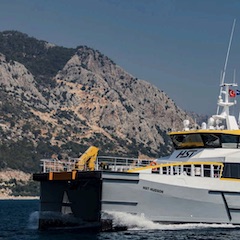Damen Shipyards Group has established a firm foothold in the European offshore wind sector over the last decade. Now the Dutch shipbuilding and maritime services company is turning its attention to the emerging market of the American offshore wind industry. Here Damen’s Director Business Development & Market Intelligence, David Stibbe and Area Manager North America, Daan Dijxhoorn, discuss some of the main issues involved in the development of offshore wind in American waters, and the way that Damen is tailoring both its services and portfolio to meet American requirements.
The fact that the offshore wind industry has its roots firmly planted in Europe is an undisputed fact. In the league table of installed power generation capacity, the UK, Germany, Denmark and the Netherlands hold the top four positions. The last five years, in particular, have seen a massive increase in installation and commissioning of new wind farms. The most notable trend is one of expansion: offshore wind farms are not only getting larger, they are also being built further out to sea in deeper, rougher waters. On top of that, components are getting bigger. While ten years ago the typical capacity for an offshore wind turbine was around 3MW, today all the biggest names in turbine production have introduced turbines capable of double digits of MW production.
Massive potential
‘Whereas the European offshore wind industry has grown very rapidly over the last two decades, and is now a very significant industry, the U.S. offshore wind industry is just getting off the starting blocks,’ says Dijxhoorn. Indeed, power production in the United States still relies heavily on non-renewable energy sources. Fossil fuels and nuclear power generate more than 80% of the country’s total energy needs.
Renewable energy sources do play a role, but only bring in around 17% of the total requirement. Looking specifically at offshore wind, there is currently only one offshore wind farm in operation in American waters, Block Island off the Rhode Island coast. This is minimal to say the least, but despite this, it can be said with certainty that the American offshore wind industry has great potential.
‘Wind, of course, is the key driver,’ continues Dijxhoorn. ‘To this end, the East Coast of the United States is a prime location for the development of offshore wind farms. Look at average speeds; they are the most relevant. From North Carolina all the way up to Newfoundland, winds speeds increase the further north you go.’
Another important point is that the northern states of the Eastern Coast, Rhode Island, Massachusetts, New York and Connecticut – are also among the most densely populated. ‘These areas require a large amount of energy, but the population density means there is less land available for power generation. Therefore, in terms of energy production and supply, offshore is the best way to go.’



























